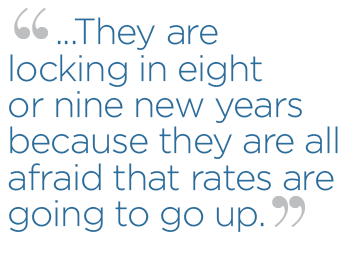Borrowers continue to take care of upcoming loan maturities early by refinancing today—even if it means paying penalties in order to do so.
Low interest rates, rising property values and incomes, and a competitive lending environment are creating a perfect storm for borrowers looking to refinance maturing loans.
“All of those things are making it a great time to refinance,” says Jamie Woodwell, vice president of commercial real estate research with the Mortgage Bankers Association (MBA), a trade group. “We have seen borrowers working as much as they can to draw forward upcoming maturities and getting them refinanced today.”
The robust refinancing activity over the past 12 to 24 months is continuing to take the edge off the looming mountain of loans coming due in 2015, 2016 and 2017. According to the most recent MBA survey, which was done at the end of 2014, the projection for loan maturities among non-bank lenders is $121 billion in 2015. That volume jumps to $223 billion in 2016 and stays relatively high at $208 billion in 2017.
What is notable is that the year-end 2013 survey had forecast $158 billion in commercial/multifamily mortgages coming due in 2015. So just over the course of 2014 the total amount of loan maturities went down by $37 billion. In fact, about one-quarter (23 percent) of the total loans set to mature this year refinanced early, and among multifamily loans specifically that amount was slightly higher, with about one-third refinancing early, according to the MBA.
That trend is expected to continue this year. Many of the 2016 loan maturities will likely be refinanced in 2015, and barring a sudden spike in interest rates, many of the 2017 loan maturities will also be refinanced ahead of their due dates. “What this is really doing in an interesting way is evening out what had been anticipated to be an exceptionally large volume of loan maturities in 2016 and 2017,” says Woodwell.
 There has been an uptick in refinancing activity, agrees Ken Fox, CCIM, managing director of capital markets in the San Francisco office of Cohen Financial, a real estate capital services company. In particular, Fox is doing a number of forward commitments that have been approved, but won’t close until the fourth quarter of the year as borrowers look to take the interest rate risk out of the equation. “I have a lot of borrowers that are refinancing early and paying pre-payment penalties in the form of pre-payment yield maintenance or defeasance,” says Fox.
There has been an uptick in refinancing activity, agrees Ken Fox, CCIM, managing director of capital markets in the San Francisco office of Cohen Financial, a real estate capital services company. In particular, Fox is doing a number of forward commitments that have been approved, but won’t close until the fourth quarter of the year as borrowers look to take the interest rate risk out of the equation. “I have a lot of borrowers that are refinancing early and paying pre-payment penalties in the form of pre-payment yield maintenance or defeasance,” says Fox.
Borrowers would rather pay the penalties now in order to access the low interest rates that still exist.
“They are basically buying insurance by doing it early. They are locking in eight or nine new years because they are all afraid that rates are going to go up,” says Fox.
Borrowers are also finding competitive mortgage rates, favorable terms and good competition among lenders. Although it varies from lender to lender, most lenders are at the point in the cycle when they are starting to loosen up a little bit in terms of loan-to-value ratios, amortization, availability of interest only loans and recourse options, says Fox.
That refinancing activity is spread across all different lender groups, from CMBS shops and life companies to agencies and banks. For example, more and more banks are becoming a viable source of capital for the “bread-and-butter” $2 million to $10 million size loans, says Fox. The drawback there is that most don’t offer 10-year fixed or longer terms, which is what a lot of borrowers are looking for.
However, banks are very active when it comes to loans in the 3- to 7-year range, and they offer an easier, lower cost execution, he says. The big hurdle is recourse, and a lot of banks are now easing up on recourse for moderate leverage loans, Fox adds.
The common view that interest rates may move higher later this year is providing an added incentive for that refinancing activity. “We have seen a lot of volatility with rates to the degree that borrowers anticipate that rates will be increasing,” says Woodwell.

